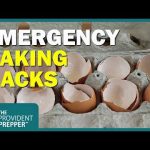In today’s world, many people are becoming more aware of the need for preparedness in case of emergencies or civil unrest. The reality is that situations can change quickly, and being ready can make a significant difference. This article looks at several essential aspects of emergency preparedness, focusing on what people can do to protect themselves and their families during troubling times, especially when martial law may be declared.
First, one of the most critical areas of focus is the need for weapons and ammunition. History has shown that during times of crisis, people may face government actions that can include the confiscation of firearms. Events like Hurricane Katrina serve as reminders that in such situations, individuals may find themselves at a disadvantage if they are not prepared. It is wise for people to consider their rights regarding weapon ownership and think carefully about how they can secure their firearms, ensuring they stay safe while also adhering to legal requirements.
Another important topic is the availability of fuel and energy. There are signs that could lead to fuel rationing, similar to what was seen during World War II. Preparedness involves not only having enough fuel for immediate needs but also looking into alternative energy sources. Solar generators, bicycles, and even hand tools can provide ways to reduce reliance on fuel if it becomes hard to obtain. By preparing for fuel shortages, individuals can maintain their ability to move about and access necessary supplies during difficult times.
Food storage is also a major concern. Recent executive orders could give the government the authority to intervene during national crises, including taking food from individuals who have stockpiled supplies. To mitigate this risk, individuals should not only build a food reserve but also consider diversifying their food storage locations. Hiding food in different parts of the home, including basements or outbuildings, can help protect it from government intervention and ensure that supplies remain available to those who need them.
Effective communication can be challenging during emergencies where conventional methods, like phones or radios, may not function correctly. In situations involving martial law, communication systems can be easily disrupted. Therefore, it is crucial to foster a network within the community. Establishing a plan for different communication methods, including meeting points, can greatly enhance group safety and coordination. This adds an extra layer of resilience, allowing communities to come together in response to challenges.
Lastly, building a strong community is of utmost importance. A single household is more vulnerable than a network of prepared individuals. By connecting with neighbors and forming a group, everyone can share resources, knowledge, and support. Throughout history, communities have been able to withstand difficult situations better when they work together. Individuals should think carefully about their own preparedness while also encouraging their neighbors to do the same.
In summary, being ready for emergencies is essential in today’s unpredictable environment. Guns and ammunition, fuel, food storage, communication strategies, and community development are all critical areas to address. By thinking ahead and taking proactive steps, individuals can enhance their preparedness and increase their chances of weathering any storm that comes their way. It is wise to plan and prepare today, as the future can often be uncertain.



GIPHY App Key not set. Please check settings